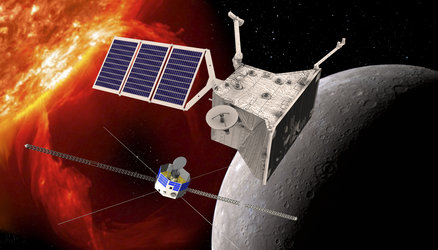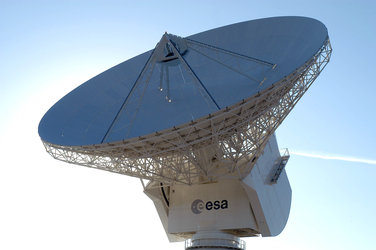Cool animations: Critical operations for BepiColombo
BepiColombo - ESA's first mission to Mercury - will be conducted in cooperation with JAXA, the Japan Aerospace Exploration Agency, and is scheduled for launch later in 2013. Scroll down to view a series of highly detailed, realistic animations showing the critical operational phases.
The mission will consist of two separate spacecraft: ESA is building the Mercury Planetary Orbiter (MPO), and the Japanese space agency JAXA will contribute the Mercury Magnetospheric Orbiter (MMO). MPO mission operations will be controlled from ESOC, the European Space Operations Centre, while MMO operations will be controlled from the Sagamihara Space Operation Center, near Tokyo.
LEOP - Launch & Early Orbit Phase
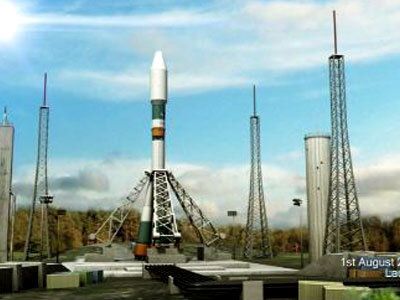
The first animation shows LEOP - the Launch and Early Orbit Phase. BepiColombo will be launched from Kourou on an upgraded Soyuz-2B rocket with a Fregat M upper stage.
- Just before lift-off, the 1st and 2nd stages of the Soyuz rocket ignite; the 1st stage comprises four boosters around the central 2nd stage
- About 2 min after launch, the four boosters separate from the 2nd stage, which continues to fire for almost 3 more mins
- Having cleared the Earth's atmosphere, the two halves of the protective fairing are ejected, revealing the Mercury Composite Spacecraft (MCS)
- The 3rd stage ignites and, immediately afterwards, the 2nd stage is shut down. After the 3rd stage is spent, the 'Fregat' stage fires to put the spacecraft into a geostationary transfer orbit
Solar array deployment
The animation clearly shows the Fregat stage separating from the Mercury Composite Spacecraft, and the deployment of both the Mercury Polar Orbiter solar panel and the end sections of the Mercury Transfer Module solar arrays. To prevent stress during subsequent orbit-raising manoeuvres, the solar arrays are not fully deployed until the end of the next phase: the Near Earth Commissioning Phase.
Near Earth Commissioning Phase
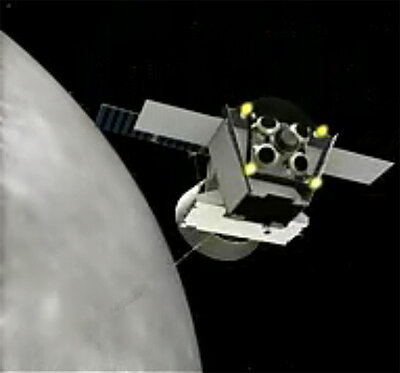
Apogee raising
After entering geostationary transfer orbit, the main engine of the Mercury Transfer Module will fire to boost the apogee (point of furthest distance from the Earth) of the Mercury Composite Spacecraft. The chemical engine will be fired around perigee (point of closest approach to the Earth) - indicated by the red tracks in the orbit animation.
Lunar gravity assist
Having reached the orbit of the Moon, a lunar gravity assist will next set the composite spacecraft on its interplanetary trajectory toward Mercury. Shortly after, the MTM's solar array is fully deployed and the advanced solar electric propulsion system is activated.
In the animation, all four ion engines are seen firing, whereas in reality only one will be switched on due to the limited power that is available. The exact direction of thrust can be selected by the steerable nozzles of the ion engines.
Interplanetary Cruise Phase
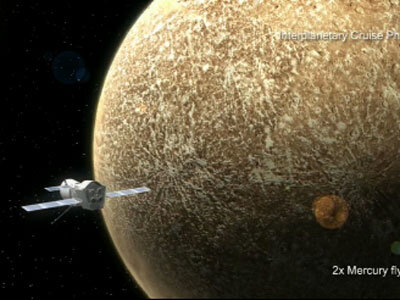
Solar power and gravitational assists
After the lunar gravity assist, the nearly 6-year interplanetary cruise phase starts. The Mercury Composite Spacecraft will use both its solar electric propulsion system and a series of five planetary swingbys (Earth, 2x Venus, 2x Mercury) to reach its destination, our Solar System's innermost planet.
The solar electric propulsion system is located in the Mercury Transfer Module (MTM) and will be activated during selected parts of the spacecraft's trajectory. The thrust arcs (when ion engines are on), are shown in red in the animation; the spacecraft's cruise through the inner Solar System as well as planetary orbits are also indicated.
Speeding up, then slowing down
When still outside the orbit of Venus, the spacecraft will be accelerated by thrusting in the direction opposite to the spacecraft's direction of travel, while the ion engines will fire in the same direction that the spacecraft is travelling - to brake against the pull of the Sun's gravity and lower the heliocentric orbit - during the remainder of the interplanetary cruise phase (after the two Venus swingbys).
Jettison propulsion module
About 2 months before capture by Mercury, the Mercury Transfer Module (MTM) is jettisoned, leaving the two Mercury orbiters to be caught by the planet's gravity.
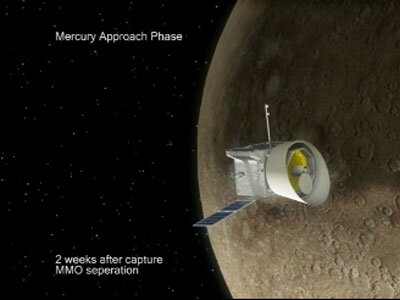
Still attached, the two orbiters are caught by Mercury as they enter the planet's gravity. Next, using both the planet's gravity and the chemical propulsion system of the Mercury Planetary Orbiter (MPO), the two attached orbiters will enter orbit around Mercury.
Periherm, apoherm lowering
The MPO's chemical propulsion system is used to lower the periherm (point of furthest distance from Mercury) and apoherm (point of closest approach to Mercury) until the operational orbit is achieved for the Mercury Magnetospheric Orbiter (MMO), some 2 weeks after capture by the planet. Here, the MMO will separate from the MPO, after which the protective sunshield and MMO interface structure are also jettisoned. The MMO will operate in a polar orbit with a periherm altitude of 400 km, an apoherm altitude of 12 000 km, and a 9.2-hour period.
After separation, the MPO's chemical propulsion system is used to further lower the orbit of the MPO alone. A series of braking burns will lower the apoherm altitude until the MPO reaches its operational orbit: 400 × 1500 km polar orbit with a period of 2.3 hours.


